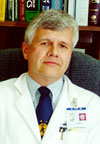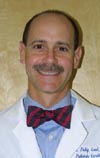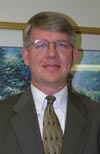Changes to build on success of MUSC Children’s Hospital
by Cindy AbolePublic Relations
 Dr.
L. Lyndon Key
Dr.
L. Lyndon Key
Administrative changes within MUSC Children’s Hospital promise to guide the future of the state’s multi-specialty hospital for children and provide more accountability and other managerial improvements to better medical care for South Carolina’s children.
 Dr.
J Phillip Saul
Dr.
J Phillip Saul
Pediatric specialists L. Lyndon Key Jr., M.D., J. Phillip Saul, M.D., and administrator Dave Neff have been named to top positions at the Children’s Hospital. Key, who is professor and chairman of pediatrics, was named physician-in-chief in this administrative change. His role establishes him as a leader and representative for children’s health services within the administration and allows him to work more closely with the hospital’s medical director and administrative director, two new positions created in the reorganization.
Saul, who heads pediatric cardiology, was named medical director and will manage patient care and chair the Medical Staff Executive Committee. As interim administrative director, Neff will help manage the day-to-day operations of the Children’s Hospital. Neff is also an administrator for the Medical Center’s Ambulatory Care Services and will temporarily wear two hats reporting directly to Medical University Hospital Authority (MUHA) Executive Director Stuart Smith.
 Dave
Neff
Dave
Neff
Since its opening in 1987, the Children’s Hospital has provided the highest level of children’s health care within the Palmetto State and beyond. Fifteen years of service and expanded medical care have resulted in clinical and outpatient care growth with a special emphasis on research. Last February, MUSC broke ground to construct the Children’s Research Institute, touted to be one of the South’s largest, most comprehensive research centers that will be the catalyst for conducting cancer, congenital heart disease, multiple sclerosis and diabetes research.
The reorganization came as a result of collaboration among Smith, Key and Jerry Reves, M.D., College of Medicine dean and vice-president of medical affairs. Key wanted to expand upon the success and vision of former Children’s Hospital Director Charles Darby, M.D. and Biemann Othersen, M.D., director of pediatric surgery. Reves’ vision outlines a plan that would integrate patient care and business services to improve the level of health care and services for children. Smith’s focus was on patient care and business accountability.
“We wanted to coordinate all activities involving children’s health that are run by the Medical Center and affiliate these services with the Children’s Hospital as a recognizable flagship,” said Key. “This new plan creates a more integrated group of services. This new approach focuses primarily on improving the way children are cared for, and identifies MUSC’s children’s services with its most recognizable brand name, the Children’s Hospital.”
The restructure moves away from the traditional disease or organ care concept to a patient-centered team approach that will shed departmental cloaks and promote specialty collaborations essentially providing a seamless system of care, Reves said. For example, the medical center’s heart and vascular services would be composed of a team of cardiac surgeons, anesthesiologists, radiologists, internists and other specialists that would be involved in a patient’s care.
“This one-stop approach for children’s care will provide all of the services needed in a patient’s treatment, while maintaining the highest level of quality care,” said Reves. Foremost on the agenda is creating and implementing an effective infrastructure that emphasizes excellence while providing world-class, cost-effective patient care. The concept will allow for more input and guidance from the Children’s Hospital staff, physicians, specialists and other associates at all levels.
“The best part about this is that the new management plan allows the Children’s Hospital facility to operate in one coordinated system where everyone is working together to provide absolutely the best level of care,” Key said. “There is a sense of pride in our Children’s Hospital that we can always build upon. The excitement is already infectious.”
In the restructuring, the Children’s Hospital will operate as a division of the Medical University Hospital Authority. The re-organization will help streamline how outpatient and inpatient services will be managed. The new leaders will work closely with Children’s Services Director Carol Dobos, Ph.D., R.N., who supervises all nursing units and ancillary care managers directly. Dobos will also help manage compliance of the facility with MUHA and other local, state and national policies and regulations.
Consequently, the restructuring will guide the Children’s Hospital to be more fiscally responsible while developing systems that reward staff performance, and the dollars saved can be reinvested for needed equipment, improvements and renovations. This reorganization comes at a time when severe federal and state Medicaid cutbacks threaten the provision of medical care and services for certain patient populations including the state’s disabled children. Never before has efficiency been more important.
“This model will test the Children’s Hospital as a virtual enterprise within MUHA to provide a measured performance of all Children’s Hospital activities,” said Smith. “This method will improve how the Medical Center determines the overall success of the care and services offered by the Children’s Hospital.”
As a member of the Children’s Hospital Executive Committee, Key will serve with Reves and Smith. The committee’s role is to review financial statements, approve budgets and confirm decisions made on behalf of the Children’s Hospital. Saul will head an advisory board that will involve physicians, nurses, administration, leaders and other medical members of the community who will share new ideas and feedback from staff to help guide the hospital’s vision.
An immediate challenge for Key and other Children’s Hospital leaders is publicizing the reorganization. Key and other Children’s Hospital leaders and staff must identify and recruit talented people as part of the health care team to meet the hospital’s overall mission. This will aid a very dedicated Children’s Hospital staff to do its jobs even more effectively and will integrate a variety of exciting programs for children that exist throughout the university and community.
An immediate challenge for Key and other Children’s Hospital leaders is publicizing the reorganization. Key and other Children’s Hospital leaders and staff must continue to identify and recruit talented people as part of the health care team to meet the hospital’s overall mission.
“When it comes time for our patients to leave the hospital, not only
are they healed by providing medical diagnoses and treatments, but we must
also focus on how they feel and the quality of treatment they have received,”
Key said. “Caring for children and their families is the right thing to
do. Attitude determines compliance with therapy or care. It also ensures
that a patient will return for follow-up care. That’s why it’s necessary
for people to feel good about their hospital experience. That’s why it
is important that we do our best.”